Reports on Plant Diseases |
RPD No. 636 - Canker and Dieback Diseases
of Woody Plants
|
April 1997
|
[ Symptoms ] [ Cause ] [ Disease
Cycle ] [ Control ]
Canker diseases are common, widespread, and destructive on a wide range
of woody plants. They may cause dieback of twigs and branches (Figure
1), or they can structurally weaken a plant until it breaks over in the
wind or during an ice storm. Cankers also slow the normal healing of wounds
and provide entry for wood decay or wilt producing fungi and other organisms.
|
Canker and dieback diseases are most common and conspicuous on trees
and shrubs under stress from any of the following: transplant shock, an
excess or deficiency of water, prolonged exposure to extremely high or
low temperatures, sudden hard freezes in mid- to late fall or spring,
summer or winter sunscald, frost cracks, nutritional imbalances, extensive
defoliation, soil compaction, changes in the soil grade, mechanical injuries
(such as hail, wind, a heavy ice or snow load, fire, lawn mowers, construction
equipment or vehicles, or rodents), pruning wounds, root rot, insect borers,
nematodes, dogs, or improper digging, storage, and shipping. Cankers are
also common in nurseries and plantations where the plants are grown closely
together.
|
Click on image for
larger version
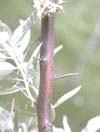
Figure 1. Phomopsis
canker
damage on Russian Olive.
Note dieback of twigs.
|
Symptoms
Click
on image for larger version
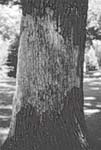
Figure 2. Smooth
or
bark patch of white oak.
Aleurodiscus fungus
is confined to dead
bark and causes no
damage to tree. |
A canker is a localized diseased area or lesion in the bark of a woody
plant and often results in an open wound. Starting as a definitely marked
dead area, usually round to oval or elongate in shape, a canker may
enlarge and girdle the twig, branch (limb), or trunk. Nearly all canker
pathogens are wound parasites. The death of the bark and underlying
cambium tissue is usually associated with a dead bud, branch stub, or
twig, or with some type of mechanical injury and extends radially from
the wound. When the water conducting tissue (xylem) is killed or blocked,
the most prominent symptom is a gradual or rapid wilting, withering,
and dieback starting at the shoot tip and progressing down the branch
— all of this being a secondary effect of the girdling canker some distance
below. The leaves on affected parts are often smaller than normal, first
pale green then yellow or brown, curled, and sparse. Large or multiple
trunk cankers may result in severe girdling and subsequent death of
the affected tree or shrub. When a canker forms on the trunk near the
soil line, it is called crown canker or collar rot (Figure 5).
|
|
Cankers may develop as conspicuous, slightly sunken or flattened areas
of bark (Figures 2 and 3), or as inconspicuous diseased areas that cannot
be detected by examining the bark surface. The diseased bark of conspicuous
sunken cankers often cracks within or at the margins, exposing the wood
beneath (Figures 3 and 4). In other cankers, such as those caused by species
of Nectria, Urnula (Strumella) (on oaks), and Eutypella
(on maples), swollen ridges of callus form a targetlike area (Figure 6).
On woody plants with light-colored bark, diseased bark that does not become
depressed may turn some shade of brown or black (Figures 7 and 8). Such
cankers are conspicuous because of their abnormal color. Inconspicuous
cankers usually appear as brown to black diseased areas just under the
bark when the thin stromata or outer bark is cut away (Figure 5). Many
canker diseases caused by fungi are indicated by raised, speck-sized or
larger, dark fruiting bodies (pycnidia, perithecia, stromata acervuli)
in the diseased bark (Figure 1). Many fruiting bodies break through the
bark and are seen as dark spots or bumps. Oozing of gum, resin, or sap
is a common sign of certain cankers (Figure 8).
|
Click on image for
larger version
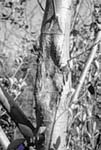
Figure 3. Cytospora
canker of poplar kills
thousands of poplar
each year
(IL Nat. Hist. Survey).
|
Cause
Click
on image for larger version
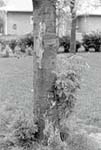
Figure 4. Kaskaskia
canker of honeylocust
kills newly planted
and large established trees
(IL Nat. Hist. Survey). |
Most cankers are caused by fungi although a few affecting fruit and
nut trees are caused by bacteria, especially by species of Erwinia,
Pseudomonas, and Xanthomonas, viruses, and other types of
pathogens. The host pathogen relationships and the pathogenicity of
numerous species of these fungi have not been thoroughly investigated.
Many of the fungi are known to be only weak or secondary pathogens.
Some have both perfect (sexual or telamorph) and imperfect (asexual
or anamorph) states, which may or may not be present at the same time
on the same plant. Thus, there is undoubtedly some duplication in the
list of host plants for many of the genera. Other minor host plants,
especially shrubs, could be added to many of the genera.
|
Click
on image for larger version
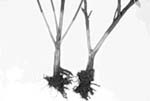
Figure 5. Phytophthora
crown
canker of azalea. Bark has
been removed to show dark
discoloration of wood
(IL Nat. Hist. Survey). |
Back to Top
Disease Cycle
Most canker forming fungi overseason as vegetative mycelium or fruiting bodies
in diseased and dead wood. They often grow in the bark of living trees or shrubs
and on dead wood both on the standing plant and on the ground.
|
Click on image for
larger version
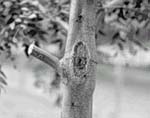
Figure 6. Nectria
canker on
sugar maple stem.
|
Perennial Cankers
A canker producing fungus enters through a mechanical wound in the bark
(such as a branch stub or mowing bruise) and invades and kills the bark,
commonly during a dormant period. At the same time, the host plant attempts
to limit invasion by the fungus by producing a layer of callus cells around
and over the edge of the invaded tissue, but the fungus invades the callus
tissue during the next dormant period. The host then forms new callus
tissue. This cycle of invasion by the fungus and formation of callus tissue
by the plant may be repeated for several years. The extent and shape of
the resulting canker is determined by the growth of the pathogen and the
amount of callus formation. The extent and shape of the resulting canker
is determined by the growth of the pathogen and the amount of callus formation.
|
Click
on image for larger version

Figure 7. Botryosphaeria
cankers on yellow twig
dogwood stems. Disease
can be devastating when
plants under stress
(IL. Nat. Hist. Survey). |
|
Click on image for
larger version

Figure 8.
Botryosphaeria
canker on
sweetgum trunk.
(IL Nat. Hist. Survey).
|
Annual Cankers
Cankers contain little or no callus and increase rapidly during a single
season. Branches or even entire trees, especially young ones, may be girdled
in one growing season. Most are caused by fungi that attack stressed or
weakened plants. Most canker fungi are restricted to invasion of bark
tissues. Some, however, colonize both the bark and the underlying xylem
tissue. Stem diseases that result from a simultaneous canker and wood
decay are called canker rots.
Canker fungi usually produce their fruiting bodies in recently killed
bark. The spores produced by these fruiting bodies serve as inoculum for
new infections, which occur mostly during wet or damp weather. The spores
(mainly conidia and ascospores) are spread primarily by air currents,
splashing rain, and contaminated pruning and shearing tools; a few are
spread by contaminated insects and birds. The spores may ooze out of fungus
fruiting bodies in long tendrils or cirrhi (Figure 9) during wet weather.
|
Click on image for
larger version

Figure 9. Chestnut
blight canker.
|
Back to Top
Control
-
Grow only species and varieties or cultivars of trees and shrubs that are
well adapted to the area and site. Plant only vigorous, disease free nursery
stock. Resistant spec-ies and cultivars are available for certain types
of canker diseases. Grow somewhat tender species in sheltered locations.
Plant at the proper depth in a large hole, well spaced apart, in fertile
well drained soil of the proper soil reaction (pH).
-
If cankers are confined to the twigs or branches, carefully remove the
affected part(s), including all dead and discolored wood, pruning several
inches behind any sign of disease. Remove and burn, or haul away
with the trash, all affected parts when first noticed. Avoid leaving branch
stubs. Pruning cuts should be made as flush with the branch or trunk as
possible leaving the "collar" that surrounds the base of the branch. Do
not prune when the bark is wet; this helps to spread the causal fungus.
Where possible, the pruning tools should be sterilized between cuts by swabbing
with 70 percent rubbing alcohol or freshly prepared liquid household bleach
(one part bleach in five parts of clean water).
-
Some trunk cankers, if less than halfway around the tree, can often be
successfully removed by careful surgery of diseased bark and underlying
discolored wood. Surgically remove serious girdling roots above and below
the soil line. This work is best done by a licensed and experienced arborist.
-
Treat all bark and wood injuries promptly. Cut away all loose or discolored
bark. Remove splintered wood. Clean, shape, and smooth the wound into a
streamlined oval or elipse with rounded tips and its long axis oriented
vertically. Then swab the wound surface liberally with an antiseptic such
as 70 percent alcohol or shellac. The use of commercial wound (tree) paints
and dressings is not recommended. Their effect is largely cosmetic.
-
Keep woody plants vigorous through
- proper applications of a balanced fertilizer in mid to late autumn
or early spring,
- thorough soaking of the soil to a 12 inch depth every 10 days during
hot, dry periods,
- pruning, and
-
winter protection.
Loosen compacted soil and any pavement or soil fill and apply a loose organic
mulch. The trunk of young, thin barked trees should be wrapped with sisalkraft
paper, special tree wrapping paper, or other appropriate material prior to
winter. Follow cultural practices suggested by University of Illinois Extension
horticulturists.
-
Avoid all unnecessary bark wounds. Keep the trunk base as dry as possible
and free of grass, weeds, or other debris that might attract rodents.
-
Make timely applications of a suggested insecticide to keep the feeding
of defoliating insects, borers, and other wood attacking pests at a minimum.
Follow recommendations of University of Illinois Extension entomologists.
-
There are no general fungicides that can be routinely applied to woody
plants to control canker diseases.
- Avoid chemical injuries. Apply herbicides, other pesticides, salt, fertilizers,
and other chemicals strictly according to label directions.
Back to Top
For further information on diseases of ornamentals contact
Nancy R. Pataky, Extension Specialist of Turf and Ornamentals, and Director
of the Plant Disease Clinic, Department of Crop Sciences, University of Illinois
at Urbana.
University of Illinois Extension provides equal
opportunities in programs and employment.
|



